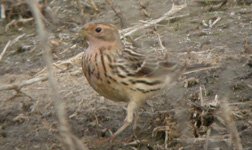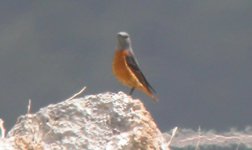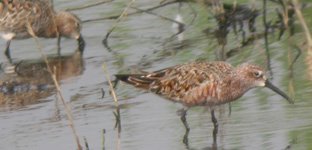The Birdbox, 29 April – 6 May 2006, Catalan Bird Tours
After seven days of ‘dash and grab’ birding in an attempt to get as many species as possible, Declan’s instructions for the week ahead came as a welcome relief - strictly nice and easy! However, even after the usual short stop-off at the Llobregat Delta (29th April 2006) before heading off to the villa to settle in, it was already clear we’d seen more than at the end of the previous Saturday. However, whether the increase from 50 to 75 species was because of our different approach, sitting and waiting in hides and strolling around slowly, would remain to be seen.
Little Bittern, Pochard and Reed Bunting, species difficult to see here without a little patience and all having avoided us last week, were already in the notebook and we had definitely picked out more species of wader as we both meticulously scanned the water’s edges. Deep black Spotted Redshank, already in summer plumage, and Ruff, catching up quickly, were the pick of the bunch but Wood Sandpiper and Greenshank were very accommodating, coming so close to the hide. However, even these were upstaged by the large water birds as Great White Egret, White Stork and some very showy Glossy Ibis added their names to the usual list of herons and Spoonbill.
The prehistoric-looking Collared Pratincoles, however, recently arrived and resting a few metres away, just tipped the stop-over Tawny Pipit, Pied Flycatcher and Northern Wheatear for title of bird of the day.
From the moment he stepped out of the car and laid eyes on the Vidala the previous day, I could see Declan’s expectations light up in his eyes. And if they were already satisfied, as he claimed, by the magic of the to-ing and fro-ing of the Llobregat Delta, they were nothing less than overwhelmed by the pair of Lammergeier we were now watching, marshalling high up in The Pyrenees (30th April 2006).
The very same spot proved typically generous with Golden Eagle, Short-toed Eagle and Griffon Vulture all passing through, Alpine Swift and Crag Martin skirting the mountain edge and two Black Woodpecker flitting from tree to tree, drumming their warnings to each other.
We eventually peeled ourselves away from our respective rock armchairs to take a short car-ride above the tree line, picking up Grey Wagtail and Nuthatch along the way and stopping off to enjoy the stunning Rock Thrush, a bird that looks as if someone had cut random pieces out of a bird magazine and pasted them together.
Once there, aside from being mesmerised by the family of Alpine Marmots at their usual watering hole, we lazed away amongst Common Crossbill, Ring Ouzel (subspecies alpestris) and, as usual gliding alongside the car, a seemingly begrudgingly mixed flock of Red-billed and Alpine Chough.
A fleeting visit from a Common Buzzard however, as we equally begrudgingly descended the mountain, ensured that the final word went to the family of the day, the raptors.
The following day, it seemed as if the word was out as, upon our arrival, Pin-tailed Sandgrouse, Great Spotted Cuckoo and Stone-Curlew did their best to compete for ‘day of the week’ on behalf of The Steppes of Lleida (1st May 2006), the latter showing itself right until the bitter end.
Black and Black-eared Wheatear, Red-rumped Swallow and both Woodchat and Southern Grey Shrikes all put in an appearance whilst our growing list of raptors expanded with Black and Red Kites and, perched on an old outbuilding, a lone male Lesser Kestrel.
Family of the day though went to the larks, with Calandra, Crested, Thekla, Short-toed and Skylark all presenting ample opportunity for identification practise.
Our visit to The Aigüamolls de L’Empordà (2nd May 2006) was timed to coincide with the peak of Red-throated Pipits passing through this north-eastern-most tip of Spain. The discovery of a small flock of summer-plumaged beauties at Vilaüt therefore and their subsequent ever-closer picks and prods into the mud provided much excitement and inspired and ensured our four-hour stay in just the one hide.
Other highlights here were Collared Pratincole, a quick stopover from a cinereocapilla Yellow Wagtail, a host of waders including summer-plumaged Dunlin and Curlew Sandpiper, freshly arrived Ortolan Bunting and an absolutely gob-smacking pair of Roller.
We eventually tore ourselves away and headed off to the main reserve where Black Tern, Penduline Tit, Spoonbill and Hobby were amongst the highlights.
A cloudy start to our day in The Llobregat Delta and Garraf Massif (3rd May 2006) may have, for many, loomed ominous but Declan just used it as an excuse to sit in a hide some more, where he happily waited to see what the rain would bring down. His reward was almost a full-set of waders including Temminck’s Stint, Avocet, Common Sandpiper and Black-tailed Godwit.
Interspersed with resident treats such as Night Heron, Common Waxbill and Purple Gallinule, other passage visitors included Audouin’s Gull and an invasion by a small group of Whiskered Terns, sheltering their White-winged and Caspian cousins amongst their number.
We awed at their sky-skating acrobatics for the best part of an hour before they left and, taking their lead, we headed off to the Garraf. Here we added to the morning’s purring European Nightjar, with Turtle Dove, Rock Bunting, all three swifts including Pallid Swift, both Woodchat and Southern Grey Shrikes and singing Dartford and Melodious Warblers. A lone Peregrine Falcon continued our onslaught into the list of raptors.
Having had the fortune to observe already most of what The Ebro Delta (4th May 2006) had to offer at Catalonia’s two other wetland sites, I offered Declan the chance to change the programme but he declined, happy to ‘see them again’. Much better views of Audouin’s Gull, along with its Slender-billed cousin, Turnstone and Bar-tailed Godwit, and a naughty school of Little Bittern, seemingly playing tag in the reed beds all ensured he did not regret his decision.
Lesser Short-toed Lark completed the set for the week, whilst the competition for ‘family of the day’ began with Reed, Great Reed, Savi’s, Cetti’s and Fan-tailed Warblers all coming within ‘bins down’ distance. Common Whitethroat also showed up and, to cap it off, a perky migrant Spectacled Warbler appeared in the very same tamarisk bush where the Western Olivaceous Warbler and Wryneck had shown themselves the week before.
Today the terns had it though, with Gull-billed, Sandwich, Common and Little greeting us throughout the day and an extended rain-induced lunch was spent sitting in the hide (where else?) at Riet Vell in the company of, for my ‘moment of the week’, Whiskered, Black and White-winged Terns all fishing not more than ten metres in front of us.
Yet again an easterly, llevante, wind was not forthcoming during the week but, for our final stop at The Cap de Creus (5th May 2006), at least conditions were a little more favourable than last week’s near blow out. We began with a first-light visit to a wooded valley I’d discovered and marked down as ‘potential’ during the winter. As the car doors opened we were immediately bathed in a wash of sound and we struggled for over an hour to keep track of the songs and calls of (and subsequently track down!) Golden Oriole, Nightingale, Woodlark, Redstart, Woodchat Shrike, both Spotted and Pied Flycatcher and, in no particular order, Melodious, Sardinian, Willow, Bonelli’s and, our target bird, the huge Orphean Warbler.
We were interrupted only (!) by a Goshawk sailing over the ridge to the east and, on the opposite side, a lone Common Buzzard picking a fight with an adult Bonelli’s Eagle!
Believe it or not, we did manage eventually to make our way to the Cap itself – entertained en route by Short-toed Eagle, Whinchat, Black-eared Wheatear, Red-rumped Swallow, Blue Rock Thrush, Crossbill and Rock, Cirl and Corn Buntings – where we arrived just in time to feast upon Balaeric Shearwaters and Northern Gannets weaving amongst the gull-trail behind the homeward bound fishing boats, accompanied occasionally by the more independent-minded Cory’s Shearwater.
Interestingly, wrapped up in the week’s events (even taking time out to go and see Barcelona play in the Nou Camp), we hadn’t always remembered to keep a daily check on our running species total but a final count showed no less than 194 species, including 16 raptors, and the verdict was in. At eleven more than last week’s hectic race, and with many more close-on experiences, ‘nice and easy’ definitely does it!
Stephen Christopher
"From the first few minutes at Llobregat I knew it would be a great trip. I've got so many fantastic memories of amazing birds and stunning landscapes and the experience has definitely inspired me to plan a return trip. I've really benefitted from the time I've spent with you, your enthusiasm and breadth of experience are obvious - Amazing!"
Declan, Client 29 April - 6 May 2006
After seven days of ‘dash and grab’ birding in an attempt to get as many species as possible, Declan’s instructions for the week ahead came as a welcome relief - strictly nice and easy! However, even after the usual short stop-off at the Llobregat Delta (29th April 2006) before heading off to the villa to settle in, it was already clear we’d seen more than at the end of the previous Saturday. However, whether the increase from 50 to 75 species was because of our different approach, sitting and waiting in hides and strolling around slowly, would remain to be seen.
Little Bittern, Pochard and Reed Bunting, species difficult to see here without a little patience and all having avoided us last week, were already in the notebook and we had definitely picked out more species of wader as we both meticulously scanned the water’s edges. Deep black Spotted Redshank, already in summer plumage, and Ruff, catching up quickly, were the pick of the bunch but Wood Sandpiper and Greenshank were very accommodating, coming so close to the hide. However, even these were upstaged by the large water birds as Great White Egret, White Stork and some very showy Glossy Ibis added their names to the usual list of herons and Spoonbill.
The prehistoric-looking Collared Pratincoles, however, recently arrived and resting a few metres away, just tipped the stop-over Tawny Pipit, Pied Flycatcher and Northern Wheatear for title of bird of the day.
From the moment he stepped out of the car and laid eyes on the Vidala the previous day, I could see Declan’s expectations light up in his eyes. And if they were already satisfied, as he claimed, by the magic of the to-ing and fro-ing of the Llobregat Delta, they were nothing less than overwhelmed by the pair of Lammergeier we were now watching, marshalling high up in The Pyrenees (30th April 2006).
The very same spot proved typically generous with Golden Eagle, Short-toed Eagle and Griffon Vulture all passing through, Alpine Swift and Crag Martin skirting the mountain edge and two Black Woodpecker flitting from tree to tree, drumming their warnings to each other.
We eventually peeled ourselves away from our respective rock armchairs to take a short car-ride above the tree line, picking up Grey Wagtail and Nuthatch along the way and stopping off to enjoy the stunning Rock Thrush, a bird that looks as if someone had cut random pieces out of a bird magazine and pasted them together.
Once there, aside from being mesmerised by the family of Alpine Marmots at their usual watering hole, we lazed away amongst Common Crossbill, Ring Ouzel (subspecies alpestris) and, as usual gliding alongside the car, a seemingly begrudgingly mixed flock of Red-billed and Alpine Chough.
A fleeting visit from a Common Buzzard however, as we equally begrudgingly descended the mountain, ensured that the final word went to the family of the day, the raptors.
The following day, it seemed as if the word was out as, upon our arrival, Pin-tailed Sandgrouse, Great Spotted Cuckoo and Stone-Curlew did their best to compete for ‘day of the week’ on behalf of The Steppes of Lleida (1st May 2006), the latter showing itself right until the bitter end.
Black and Black-eared Wheatear, Red-rumped Swallow and both Woodchat and Southern Grey Shrikes all put in an appearance whilst our growing list of raptors expanded with Black and Red Kites and, perched on an old outbuilding, a lone male Lesser Kestrel.
Family of the day though went to the larks, with Calandra, Crested, Thekla, Short-toed and Skylark all presenting ample opportunity for identification practise.
Our visit to The Aigüamolls de L’Empordà (2nd May 2006) was timed to coincide with the peak of Red-throated Pipits passing through this north-eastern-most tip of Spain. The discovery of a small flock of summer-plumaged beauties at Vilaüt therefore and their subsequent ever-closer picks and prods into the mud provided much excitement and inspired and ensured our four-hour stay in just the one hide.
Other highlights here were Collared Pratincole, a quick stopover from a cinereocapilla Yellow Wagtail, a host of waders including summer-plumaged Dunlin and Curlew Sandpiper, freshly arrived Ortolan Bunting and an absolutely gob-smacking pair of Roller.
We eventually tore ourselves away and headed off to the main reserve where Black Tern, Penduline Tit, Spoonbill and Hobby were amongst the highlights.
A cloudy start to our day in The Llobregat Delta and Garraf Massif (3rd May 2006) may have, for many, loomed ominous but Declan just used it as an excuse to sit in a hide some more, where he happily waited to see what the rain would bring down. His reward was almost a full-set of waders including Temminck’s Stint, Avocet, Common Sandpiper and Black-tailed Godwit.
Interspersed with resident treats such as Night Heron, Common Waxbill and Purple Gallinule, other passage visitors included Audouin’s Gull and an invasion by a small group of Whiskered Terns, sheltering their White-winged and Caspian cousins amongst their number.
We awed at their sky-skating acrobatics for the best part of an hour before they left and, taking their lead, we headed off to the Garraf. Here we added to the morning’s purring European Nightjar, with Turtle Dove, Rock Bunting, all three swifts including Pallid Swift, both Woodchat and Southern Grey Shrikes and singing Dartford and Melodious Warblers. A lone Peregrine Falcon continued our onslaught into the list of raptors.
Having had the fortune to observe already most of what The Ebro Delta (4th May 2006) had to offer at Catalonia’s two other wetland sites, I offered Declan the chance to change the programme but he declined, happy to ‘see them again’. Much better views of Audouin’s Gull, along with its Slender-billed cousin, Turnstone and Bar-tailed Godwit, and a naughty school of Little Bittern, seemingly playing tag in the reed beds all ensured he did not regret his decision.
Lesser Short-toed Lark completed the set for the week, whilst the competition for ‘family of the day’ began with Reed, Great Reed, Savi’s, Cetti’s and Fan-tailed Warblers all coming within ‘bins down’ distance. Common Whitethroat also showed up and, to cap it off, a perky migrant Spectacled Warbler appeared in the very same tamarisk bush where the Western Olivaceous Warbler and Wryneck had shown themselves the week before.
Today the terns had it though, with Gull-billed, Sandwich, Common and Little greeting us throughout the day and an extended rain-induced lunch was spent sitting in the hide (where else?) at Riet Vell in the company of, for my ‘moment of the week’, Whiskered, Black and White-winged Terns all fishing not more than ten metres in front of us.
Yet again an easterly, llevante, wind was not forthcoming during the week but, for our final stop at The Cap de Creus (5th May 2006), at least conditions were a little more favourable than last week’s near blow out. We began with a first-light visit to a wooded valley I’d discovered and marked down as ‘potential’ during the winter. As the car doors opened we were immediately bathed in a wash of sound and we struggled for over an hour to keep track of the songs and calls of (and subsequently track down!) Golden Oriole, Nightingale, Woodlark, Redstart, Woodchat Shrike, both Spotted and Pied Flycatcher and, in no particular order, Melodious, Sardinian, Willow, Bonelli’s and, our target bird, the huge Orphean Warbler.
We were interrupted only (!) by a Goshawk sailing over the ridge to the east and, on the opposite side, a lone Common Buzzard picking a fight with an adult Bonelli’s Eagle!
Believe it or not, we did manage eventually to make our way to the Cap itself – entertained en route by Short-toed Eagle, Whinchat, Black-eared Wheatear, Red-rumped Swallow, Blue Rock Thrush, Crossbill and Rock, Cirl and Corn Buntings – where we arrived just in time to feast upon Balaeric Shearwaters and Northern Gannets weaving amongst the gull-trail behind the homeward bound fishing boats, accompanied occasionally by the more independent-minded Cory’s Shearwater.
Interestingly, wrapped up in the week’s events (even taking time out to go and see Barcelona play in the Nou Camp), we hadn’t always remembered to keep a daily check on our running species total but a final count showed no less than 194 species, including 16 raptors, and the verdict was in. At eleven more than last week’s hectic race, and with many more close-on experiences, ‘nice and easy’ definitely does it!
Stephen Christopher
Attachments
Last edited:






